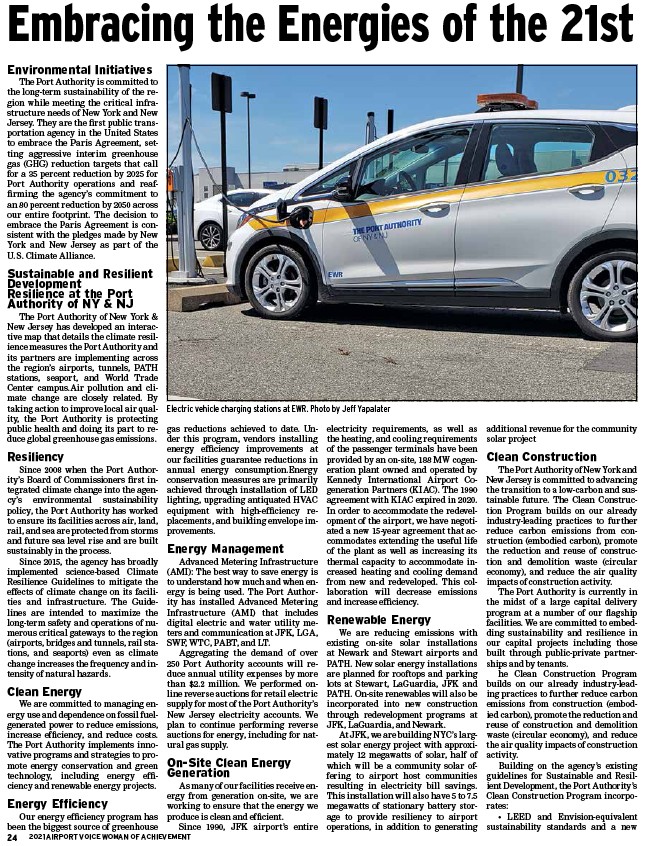
Embracing the Energies of the 21st
Environmental Initiatives
The Port Authority is committed to
the long-term sustainability of the region
while meeting the critical infrastructure
needs of New York and New
Jersey. They are the first public transportation
agency in the United States
to embrace the Paris Agreement, setting
aggressive interim greenhouse
gas (GHG) reduction targets that call
for a 35 percent reduction by 2025 for
Port Authority operations and reaffirming
the agency’s commitment to
an 80 percent reduction by 2050 across
our entire footprint. The decision to
embrace the Paris Agreement is consistent
with the pledges made by New
York and New Jersey as part of the
U. S. Climate Alliance.
Sustainable and Resilient
Development
Resilience at the Port
Authority of NY & NJ
The Port Authority of New York &
New Jersey has developed an interactive
map that details the climate resilience
measures the Port Authority and
its partners are implementing across
the region’s airports, tunnels, PATH
stations, seaport, and World Trade
Center campus.Air pollution and climate
change are closely related. By
taking action to improve local air quality,
the Port Authority is protecting
public health and doing its part to reduce
global greenhouse gas emissions.
Resiliency
Since 2008 when the Port Authority’s
Board of Commissioners first integrated
climate change into the agency’s
environmental sustainability
policy, the Port Authority has worked
to ensure its facilities across air, land,
rail, and sea are protected from storms
and future sea level rise and are built
sustainably in the process.
Since 2015, the agency has broadly
implemented science-based Climate
Resilience Guidelines to mitigate the
effects of climate change on its facilities
and infrastructure. The Guidelines
are intended to maximize the
long-term safety and operations of numerous
critical gateways to the region
(airports, bridges and tunnels, rail stations,
and seaports) even as climate
change increases the frequency and intensity
of natural hazards.
Clean Energy
We are committed to managing energy
use and dependence on fossil fuelgenerated
power to reduce emissions,
increase efficiency, and reduce costs.
The Port Authority implements innovative
programs and strategies to promote
energy conservation and green
technology, including energy efficiency
and renewable energy projects.
Energy Efficiency
Our energy efficiency program has
been the biggest source of greenhouse
gas reductions achieved to date. Under
this program, vendors installing
energy efficiency improvements at
our facilities guarantee reductions in
annual energy consumption.Energy
conservation measures are primarily
achieved through installation of LED
lighting, upgrading antiquated HVAC
equipment with high-efficiency replacements,
2021 AIRPORT V 24 OICE WOMAN OF ACHIEVEMENT
and building envelope improvements.
Energy Management
Advanced Metering Infrastructure
(AMI): The best way to save energy is
to understand how much and when energy
is being used. The Port Authority
has installed Advanced Metering
Infrastructure (AMI) that includes
digital electric and water utility meters
and communication at JFK, LGA,
SWF, WTC, PABT, and LT.
Aggregating the demand of over
250 Port Authority accounts will reduce
annual utility expenses by more
than $2.2 million. We performed online
reverse auctions for retail electric
supply for most of the Port Authority’s
New Jersey electricity accounts. We
plan to continue performing reverse
auctions for energy, including for natural
gas supply.
On-Site Clean Energy
Generation
As many of our facilities receive energy
from generation on-site, we are
working to ensure that the energy we
produce is clean and efficient.
Since 1990, JFK airport’s entire
electricity requirements, as well as
the heating, and cooling requirements
of the passenger terminals have been
provided by an on-site, 188 MW cogeneration
plant owned and operated by
Kennedy International Airport Cogeneration
Partners (KIAC). The 1990
agreement with KIAC expired in 2020.
In order to accommodate the redevelopment
of the airport, we have negotiated
a new 15-year agreement that accommodates
extending the useful life
of the plant as well as increasing its
thermal capacity to accommodate increased
heating and cooling demand
from new and redeveloped. This collaboration
will decrease emissions
and increase efficiency.
Renewable Energy
We are reducing emissions with
existing on-site solar installations
at Newark and Stewart airports and
PATH. New solar energy installations
are planned for rooftops and parking
lots at Stewart, LaGuardia, JFK and
PATH. On-site renewables will also be
incorporated into new construction
through redevelopment programs at
JFK, LaGuardia, and Newark.
At JFK, we are building NYC’s largest
solar energy project with approximately
12 megawatts of solar, half of
which will be a community solar offering
to airport host communities
resulting in electricity bill savings.
This installation will also have 5 to 7.5
megawatts of stationary battery storage
to provide resiliency to airport
operations, in addition to generating
additional revenue for the community
solar project
Clean Construction
The Port Authority of New York and
New Jersey is committed to advancing
the transition to a low-carbon and sustainable
future. The Clean Construction
Program builds on our already
industry-leading practices to further
reduce carbon emissions from construction
(embodied carbon), promote
the reduction and reuse of construction
and demolition waste (circular
economy), and reduce the air quality
impacts of construction activity.
The Port Authority is currently in
the midst of a large capital delivery
program at a number of our flagship
facilities. We are committed to embedding
sustainability and resilience in
our capital projects including those
built through public-private partnerships
and by tenants.
he Clean Construction Program
builds on our already industry-leading
practices to further reduce carbon
emissions from construction (embodied
carbon), promote the reduction and
reuse of construction and demolition
waste (circular economy), and reduce
the air quality impacts of construction
activity.
Building on the agency’s existing
guidelines for Sustainable and Resilient
Development, the Port Authority’s
Clean Construction Program incorporates:
• LEED and Envision-equivalent
sustainability standards and a new
Electric vehicle charging stations at EWR. Photo by Jeff Yapalater